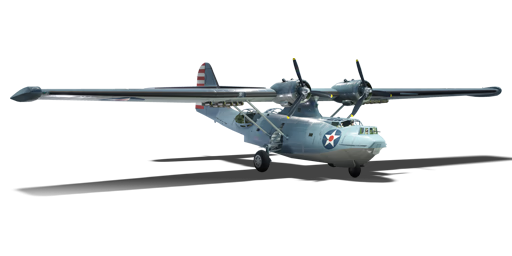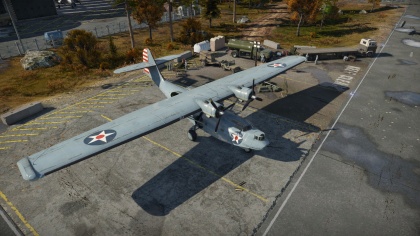PBY-5A Catalina
Contents
| This page is about the American bomber PBY-5A Catalina. For the Russian version, see PBY-5a Catalina (USSR). For other versions, see PBY-5 (Family). |
Description
The PBY-5A Catalina is a rank I American bomber
with a battle rating of 1.7 (AB/RB) and 2.0 (SB). It has been in the game since the start of the Open Beta Test prior to Update 1.27.
General info
Flight performance
Describe how the aircraft behaves in the air. Speed, manoeuvrability, acceleration and allowable loads - these are the most important characteristics of the vehicle.
| Characteristics | |||||||
|---|---|---|---|---|---|---|---|
| Stock | |||||||
| Max Speed (km/h at 2,135 m) |
Max altitude (meters) |
Turn time (seconds) |
Rate of climb (meters/second) |
Take-off run (meters) | |||
| AB | RB | AB | RB | AB | RB | ||
| 259 | 249 | 4420 | 31.0 | 31.9 | 2.6 | 2.6 | 364 |
| Upgraded | |||||||
| Max Speed (km/h at 2,135 m) |
Max altitude (meters) |
Turn time (seconds) |
Rate of climb (meters/second) |
Take-off run (meters) | |||
| AB | RB | AB | RB | AB | RB | ||
| 310 | 282 | 4420 | 29.1 | 30.0 | 8.7 | 5.1 | 364 |
Details
| Features | ||||
|---|---|---|---|---|
| Combat flaps | Take-off flaps | Landing flaps | Air brakes | Arrestor gear |
| X | X | X | X | X |
| Limits | ||||
|---|---|---|---|---|
| Wing-break speed (km/h) |
Gear limit (km/h) |
Combat flaps (km/h) |
Max Static G | |
| + | - | |||
| 0 | 450 | 520 | ~2 | ~2 |
| Optimal velocities | |||
|---|---|---|---|
| Ailerons (km/h) |
Rudder (km/h) |
Elevators (km/h) |
Radiator (km/h) |
| < 220 | < 220 | < 230 | > 312 |
| Compressor (RB/SB) | ||
|---|---|---|
| Setting 1 | ||
| Optimal altitude | 100% Engine power | WEP Engine power |
| 1,886 m | 1,050 hp | 1,491 hp |
Survivability and armour
Armour plates
- 9.5 mm steel pilot seats
- 6.35 mm steel behind tail gunner
- 6.35 mm and 4.7 mm steel plates inside the structural pylon
Critical component protection
- 2 self-sealing fuel tanks in the wings
Armaments
Suspended armament
The PBY-5A Catalina can be outfitted with the following ordnance:
- 16 x 100 lb AN-M30A1 bombs (1,600 lb total)
- 4 x 500 lb AN-M64A1 bombs (2,000 lb total)
- 4 x 1,000 lb AN-M65A1 bombs (4,000 lb total)
- 4 x Type A Mark I mines
- 2 x 1,927 lb Mk.13-1 torpedoes
- 2 x 1,927 lb Mk.13-1 Case torpedoes
Defensive armament
The PBY-5A Catalina is defended by:
- 1 x 12.7 mm Browning M2 machine gun, 2 x beam turrets (478 rpg)
- 1 x 7.62 mm Browning machine gun, nose turret (1,000 rpg)
- 1 x 7.62 mm Browning machine gun, ventral turret (500 rpg)
Usage in battles
Although the PBY-5a Catalina is slow and clunky, it offers a heavy payload that is sure to be a game changer if used properly. It also has a very good defensive armament for its tier, which can occasionally be a saviour against an enemy fighter.
The plane is quite unmanouevrable, and its wings are very weak, being able to snap just by turning just a little too tight at higher speeds in a Realistic Battle. Unlike its predecessor, this version has landing gear, allowing it to land on airfields as well as in water, allowing it to repair and respawn at airfields in Realistic Mode without belly landing, and enabling it to capture bases in Airfield Domination mode in Arcade Battles.
Manual Engine Control
| MEC elements | ||||||
|---|---|---|---|---|---|---|
| Mixer | Pitch | Radiator | Supercharger | Turbocharger | ||
| Oil | Water | Type | ||||
| Not controllable | Controllable Auto control available |
Not controllable Not auto controlled |
Controllable Not auto controlled |
Combined | Not controllable 1 gear |
Not controllable |
Modules
| Tier | Flight performance | Survivability | Weaponry | |||
|---|---|---|---|---|---|---|
| I | Fuselage repair | Radiator | Turret 7 mm | LTC-5 | ||
| II | Compressor | Airframe | New 7 mm MGs (turret) | MBC-5 | Improved Torpedo | |
| III | Wings repair | Engine | Turret 12 mm | Mk 12 Mod 0 | ||
| IV | Engine injection | Cover | New 12 mm MGs (turret) | LBC-5 | ||
- The bomb load upgrades allow an increase in total bomb load, from 1,600 lb through 2,000 lb to 4,000 lb so they are a priority, especially since the bigger bombs also allow for destroying ships or tanks.
Pros and cons
Pros:
- Good bomb load
- Good defensive weaponry.
- Can land on airfields compared to other flying boats.
- Can land on water.
- Can capture points (in Naval)
Cons:
- Very slow, not a plane for the impatient.
- Humble engine power and bad rate of climb.
- Poor energy retention.
- Susceptible to ripping wings.
- Poor downward facing armament.
History
Describe the history of the creation and combat usage of the aircraft in more detail than in the introduction. If the historical reference turns out to be too long, take it to a separate article, taking a link to the article about the vehicle and adding a block "/ History" (example: https://wiki.warthunder.com/(Vehicle-name)/History) and add a link to it here using the main template. Be sure to reference text and sources by using <ref></ref>, as well as adding them at the end of the article with <references />. This section may also include the vehicle's dev blog entry (if applicable) and the in-game encyclopedia description (under === In-game description ===, also if applicable).
In-game description
There were two firms competing for the naval patrol bomber supply contract: Consolidated and Douglas. Although both prototypes met the U. S. Navy demands, on June 29, 1935 the contract was awarded to Consolidated due to lower production costs (the firm projected the cost of one aircraft to be $90,000, while their colleagues from Douglas quoted $110,000).
Manufacturing orders for PBY-2 and PBY-3 were concluded before the delivery of the first production aircraft from the previous series (accordingly, PBY-1 and PBY-2). However, when the order for PBY-4 was signed toward the end of 1937, which consisted of just 33 boat planes (this was the smallest of the PBY series), by the time production began the model was already considered outdated and likely to be the last of the series (when PBY-5 was commissioned, development of the next series of hydroplanes set to replace PBY was already underway).
That's exactly what would have happened if the Germans hadn't attacked Poland on September 1, 1939, thus greatly increasing the demand for patrol aircraft.
The last three models in the PBY-4 series had a series of distinguishing features, many of which were kept and implemented in PBY-5. In 1939, the last PBY-4 built, BuNo 1245 was converted into an amphibian through the introduction of retractable undercarriage. The amphibian version of PBY-5 was redesignated PBY-5A, and looked promising enough to compel the U. S. Navy to modify their original order for 200 PBY-5 units so that 33 of those aircraft were executed as PBY-5A. This was followed by other supply agreements for additional 186 units of PBY-5A. Other countries followed suit, changing a portion of the ordered PBY-5 units to PBY-5A.
The PBY was used as a bomber and torpedo carrier, and was often utilized in night operations, as well as on patrol, rescue and transportation missions.
Media
See also
External links
| Consolidated Aircraft Corporation | |
|---|---|
| Bombers | PBY-5 Catalina · PBY-5A Catalina |
| PB4Y-2 | |
| B-24D-25-CO | |
| Export | ▄Catalina Mk IIIa · ▂PBY-5A Catalina · ▄PBY-5A Late · ␗PB4Y-2 · ▄PB4Y-2 |
| USA bombers | |
|---|---|
| Dive | SB2U-2 · SB2U-3 · SBD-3 · SB2C-1C · SB2C-4 |
| Torpedo | TBD-1 · PBY-5 Catalina · PBY-5A Catalina · TBF-1C · BTD-1 |
| Medium | B-10B · B-18A · B-34 · PV-2D · B-25J-1 · B-25J-20 · A-26C-45 · A-26C-45DT · B-26B |
| Heavy | B-17E · B-17E/L · B-17G-60-VE · PB4Y-2 · B-24D-25-CO · B-29A-BN |
| Hydroplanes | OS2U-1 · OS2U-3 · PBM-1 "Mariner" · PBM-3 "Mariner" · PBM-5A "Mariner" |





